Build a Sales Funnel Builder That Actually Converts
Tired of funnels that fail? Learn to build an interactive sales funnel builder that captures high-quality leads and drives growth. Your practical guide.
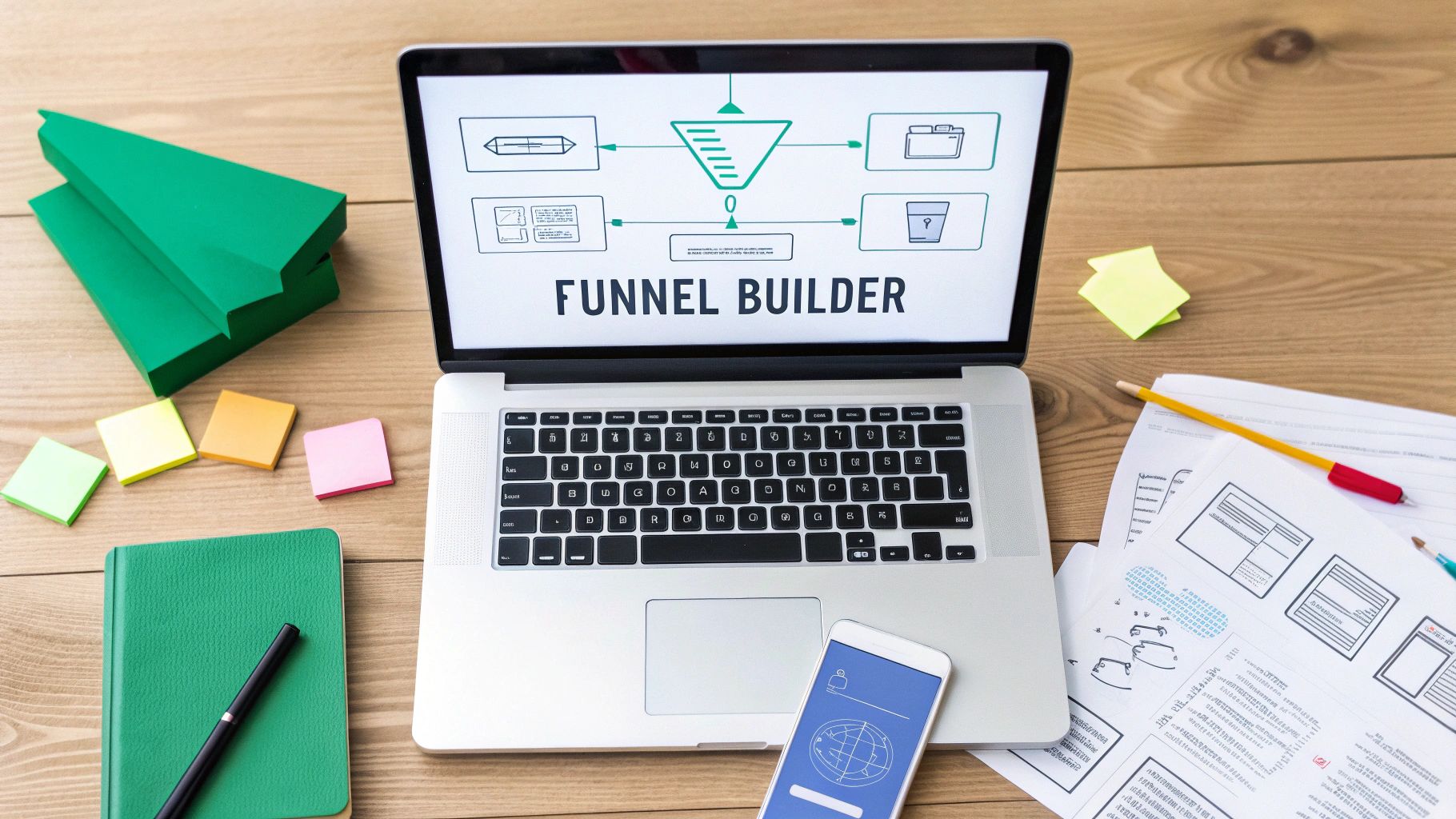
At its core, a sales funnel builder is a piece of software that lets you map out and automate the journey your customers take, guiding them from that first "hello" all the way to a sale. But the really effective builders today are all about creating interactive experiences that actually qualify leads, not just handing out static content like a PDF.
Why Your Static Sales Funnel Is Quietly Failing You
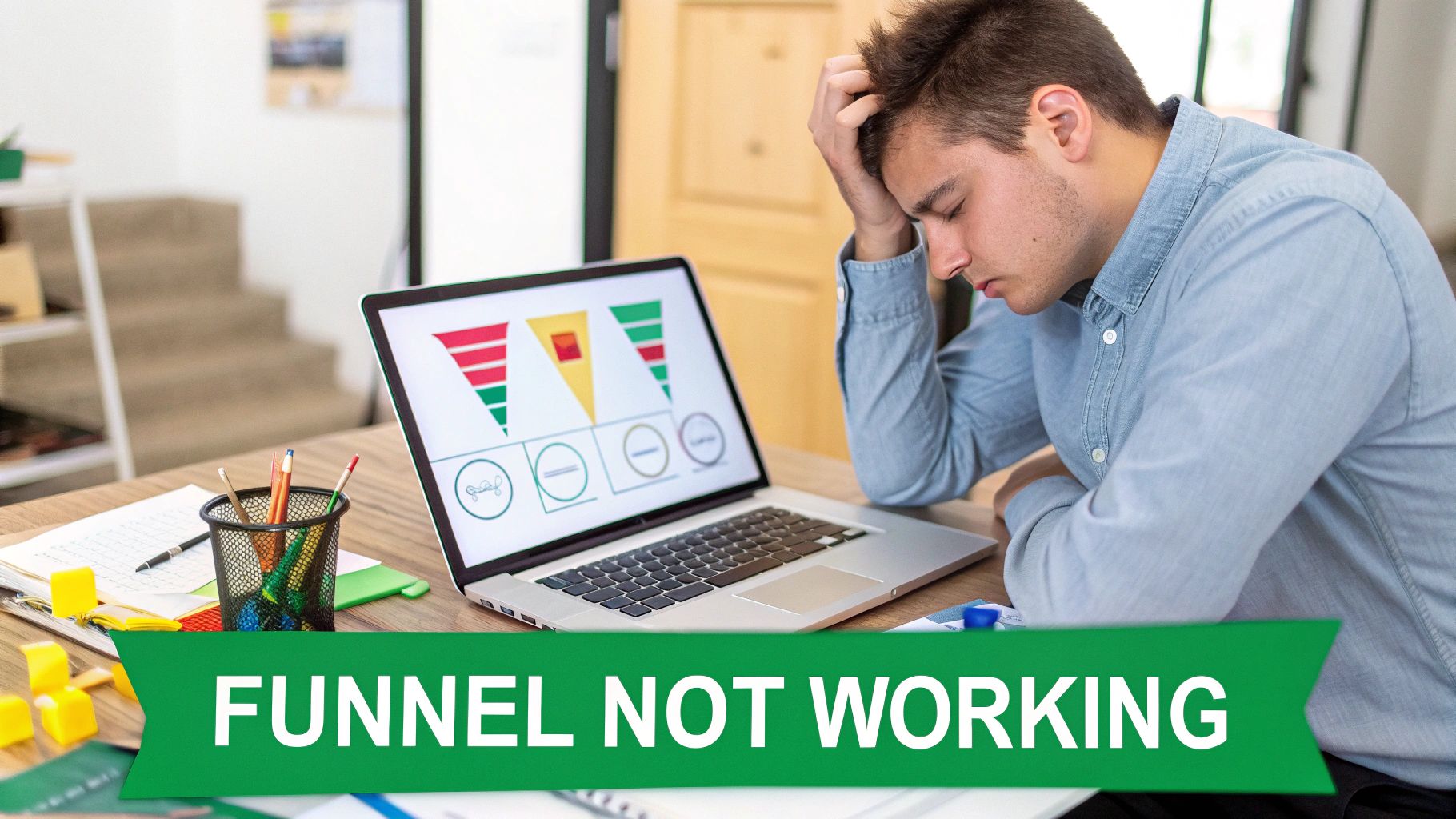
You’ve probably done everything the gurus told you to do. You mapped the customer journey, built a sleek landing page, crafted the email sequence, and even designed a fancy lead magnet. And yet... the leads feel lukewarm, engagement is dismal, and all that expensive traffic isn’t turning into real sales conversations.
If you feel like you're pushing a massive boulder uphill, you're not imagining it. That struggle is a dead giveaway that the old, one-size-fits-all funnel model is fundamentally broken. It treats every visitor as if they're the exact same person with the exact same problem—a surefire way to get ignored in a crowded market.
The Rise of Lead Magnet Fatigue
The real culprit here is something I've come to call "lead magnet fatigue." Your ideal customers are absolutely drowning in a sea of generic content. They simply don’t want another 10-page ebook promising "5 Secrets to Success" or a pre-recorded webinar that should have just been an email.
These static assets feel like a cold transaction, not a warm conversation. They demand an email in exchange for passive information, and most people have become completely numb to that offer. This is why your download numbers might look decent, but the number of qualified, engaged leads is often painfully low.
I spent years building those exact kinds of funnels, and the story was always the same: my email list was full of digital ghosts. Someone would grab the PDF and then vanish forever. It felt less like building genuine connections and more like just adding to the internet's background noise.
Shifting from Monologue to Dialogue
The big breakthrough came when I stopped thinking of funnels as a rigid, one-way slide and started seeing them as a two-way conversation. A traditional sales funnel builder helps you create a monologue where you do all the talking. An interactive sales funnel builder, on the other hand, helps you create a genuine dialogue.
Instead of just pushing information at people, you pull them into an experience. Think about the difference:
- A quiz that helps them diagnose a critical business problem.
- A calculator that reveals their potential ROI from working with you.
- An assessment that grades their current strategy and gives them personalised tips.
These tools don't just broadcast information; they deliver immediate, personal value. The user has to actively participate, which is the very first step in qualifying themselves. They're leaning in, investing their time and thought, and in the process, telling you exactly what they need help with. This is how you collect not just an email, but crucial data about their goals, pains, and priorities.
The biggest mistake we make is building funnels that broadcast a single message to a diverse audience. True conversion happens when the user feels seen and understood, which is impossible with a static PDF but entirely possible with a simple interactive tool.
Static vs Interactive Funnels: A Quick Comparison
The difference in approach is stark. One is passive and generic; the other is active and personal. Getting your head around this distinction is the first step toward building a sales machine that doesn't just collect contacts but actually creates customers.
Here's how the two models stack up against each other.
| Feature | Static Funnel (The Old Way) | Interactive Funnel Builder (The New Way) |
|---|---|---|
| User Experience | Passive consumption (reading, watching). The user is a spectator. | Active participation (answering, calculating). The user is a participant. |
| Lead Magnet | A downloadable asset, like an ebook, checklist, or webinar recording. | An embedded tool, like a quiz, calculator, or assessment. |
| Data Collection | Gathers basic contact information (name, email). | Collects valuable zero-party data (goals, challenges, budget, needs). |
| Lead Quality | Low to medium. Attracts a wide audience, many of whom are not ready to buy. | High. The act of engagement filters for more motivated and interested prospects. |
| Follow-Up | Generic, one-size-fits-all email nurture sequence. | Personalised and segmented follow-up based on the user's answers. |
It's clear that the interactive approach is built for today's buyer, who expects personalisation and immediate value.
If you're wondering if your current lead magnet is pulling its weight, our Magnethive tool can give you a completely free and instant analysis. It generates a comprehensive report on your existing lead magnet and even gives you AI-powered ideas for new interactive tools you could build. It's an easy way to spot the gaps in your current strategy.
Ultimately, the goal is to stop shouting into the void and start having smart, automated conversations that guide the right people to your solution. The rest of this guide will show you exactly how to build that system from the ground up.
Mapping Your Customer's Real Journey
Before you even think about design or code, the real work needs to happen. A high-converting sales funnel builder isn't some rigid slide you force people down. It’s a responsive, intelligent map that adapts to your customer’s actual choices and questions. For a moment, forget everything you think you know about those generic customer avatars.
Here’s a slightly controversial take: those neat, tidy personas with fake names and stock photos are mostly useless. They might describe a demographic, but they tell you absolutely nothing about the internal struggle that actually drives someone to buy. Building for them leads you to create funnels for "Marketing Mike," a 35-year-old who likes hiking, instead of for the person grappling with a specific, expensive business problem.
From Vague Avatars to Sharp Problem Profiles
The real magic starts when you stop defining your customer by who they are and start defining them by the problem they have. This is the crucial shift from a generic avatar to what I call a sharp problem profile.
A problem profile is a detailed picture of the pain point your product or service solves. It zeroes in on the trigger, the questions, the anxieties, and the ultimate outcome that person is chasing.
- Instead of: "SaaS Sally, a tech-savvy manager."
- Think: "The 'My Team's Productivity Dropped 20%' Problem." This person isn't just idly looking for software. They're under pressure, actively searching for answers, and trying to diagnose a complex issue.
When you build for the problem, your entire approach changes. You stop churning out generic content and start building a tool that helps them solve a small piece of that problem right away. You give them a taste of the transformation you offer. This is the bedrock of an effective interactive sales funnel builder.
This infographic shows the typical progression from a leaky, static model to a more effective interactive approach.
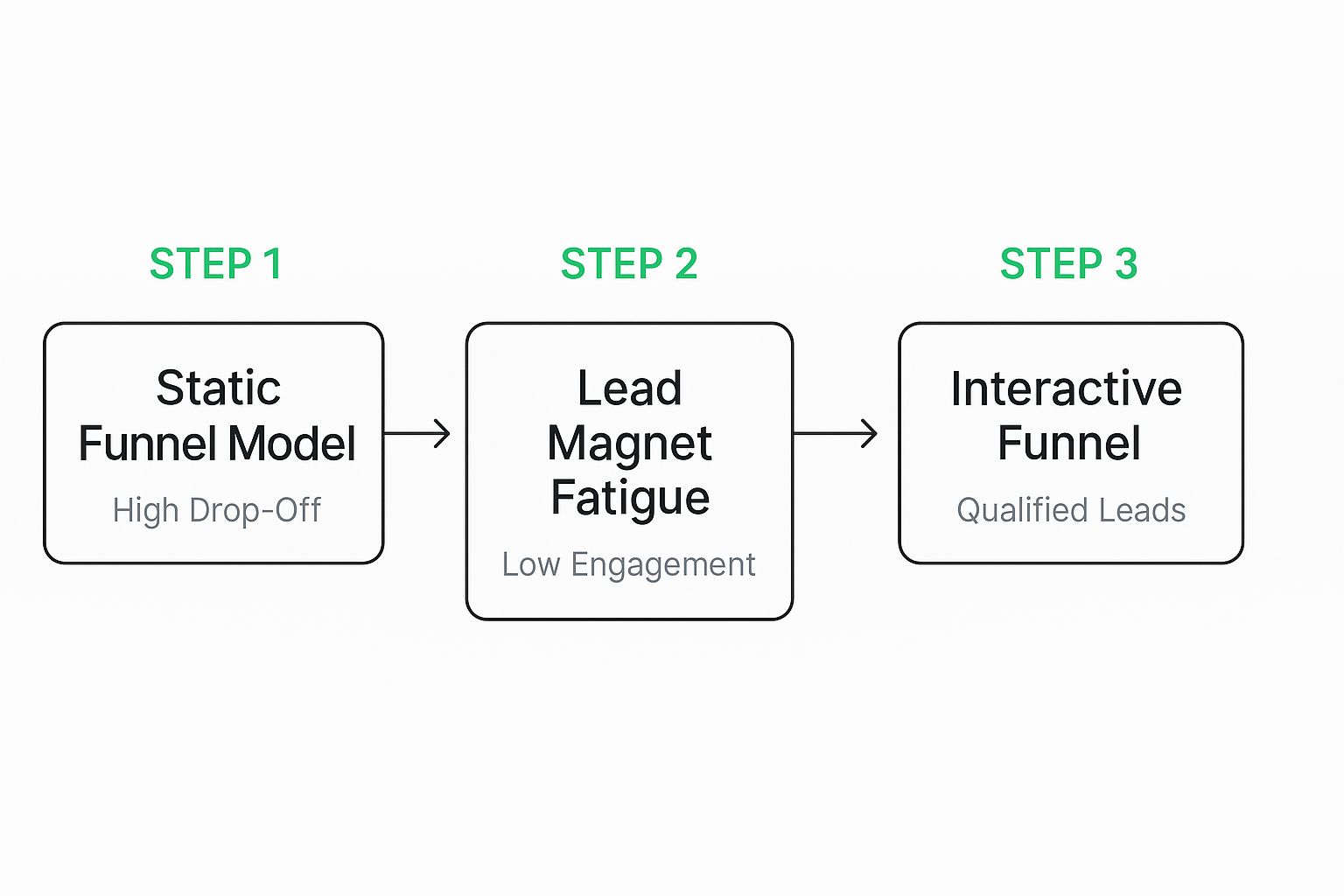
As you can see, shifting from passive content consumption to an active, engaging experience directly tackles high drop-off rates and qualifies leads far more effectively.
Visualising the Path Your Best Customers Take
Once you've nailed down your problem profiles, it’s time to map the actual journey. Don't just assume you know the path; your job is to uncover it. This isn't about creating some perfect, linear flowchart. It’s about mapping the messy, real-world process of discovery and decision-making.
I tend to use simple flowchart tools like Miro or Whimsical for this. The goal isn't a beautiful diagram; it's a functional blueprint that flags every key decision point, every question, and every potential roadblock.
Your funnel shouldn't feel like a sales pitch. It should feel like a helpful diagnosis. Each step must answer a question, provide a piece of value, and build enough trust to earn the next click.
Let's take a B2B SaaS company as an example. Their best customer's journey might look something like this:
- Trigger: They get a report showing their customer acquisition cost has skyrocketed.
- Initial Search: They immediately start Googling "how to lower customer acquisition cost."
- Discovery: They stumble upon your interactive "CAC Savings Calculator." This is a critical first touchpoint.
- Interaction: They plug in their data—ad spend, conversions—and get an instant, personalised report showing their potential savings.
- Decision Point: Does this report provide genuine insight? If the answer is yes, they begin to trust you.
- Next Step: The results page gives them a clear, logical call-to-action, like booking a strategy session to actually implement the findings.
Each step is just a small micro-commitment. You're not asking for a marriage on the first date. You're simply providing value and guiding them to the next logical step in their own problem-solving journey. This mapping process ensures your sales funnel builder isn't just a random collection of pages, but a cohesive system designed to prevent leads from leaking out. For those specifically in the B2B space, mapping this complex buyer journey is essential; you can find a more in-depth look at building a sales funnel for B2B here to complement these concepts.
Your Unfair Advantage Is Interactive Content
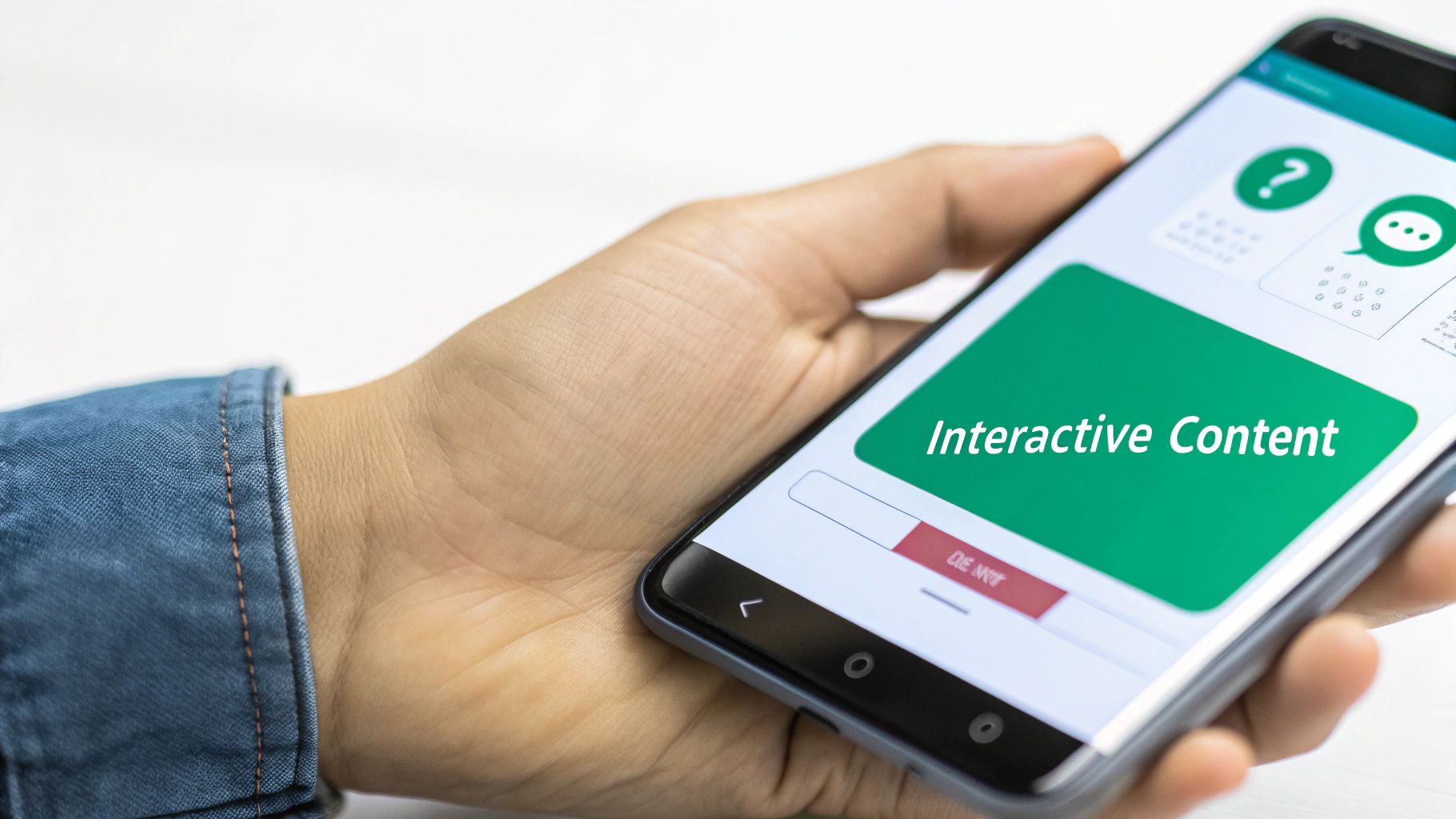
This is where we stop acting like librarians, simply handing out passive content, and start thinking like engineers, building active experiences. For years, the standard playbook was simple: offer a downloadable PDF in exchange for an email. But that well has run dry. Your potential customers don't want another ebook to clutter their digital "read later" pile.
So, here’s a thought that might feel a bit radical: stop creating traditional lead magnets altogether. Instead, let your sales funnel builder become the lead magnet.
This shift means the front door to your business is no longer a static document. It’s an interactive tool that delivers an immediate, personalised "aha!" moment. Think of it as a Trojan horse for genuine value. You’re not just gatekeeping information behind an email form; you're offering a solution to a small, tangible piece of their problem, right then and there.
The Psychology of Participation
Why does this approach work so much better? It taps directly into how people are wired. When someone actively participates—by answering a few questions, plugging in their own numbers, or working through a quick assessment—they become personally invested in what comes next.
This simple act of engagement does three incredibly powerful things:
- It Sparks Curiosity: An interactive tool immediately creates an open loop. The user needs to see their results, their score, or their personalised diagnosis.
- It Builds Micro-Commitments: Every click and every answer is a tiny "yes," which psychologically primes them to take the next, bigger step with you.
- It Delivers Instant Gratification: Unlike a PDF they have to set aside time to read, a calculator or quiz provides immediate, bespoke feedback.
This isn’t just about nabbing a contact. It's about starting a meaningful, data-rich conversation from the very first click. You learn more from three thoughtful quiz answers than you ever could from an email address alone.
Moving Beyond Static, AI-Generated Fluff
The market is absolutely flooded with low-effort, AI-generated ebooks and blog posts. While AI is a fantastic assistant, letting it create your core value proposition is a race to the bottom. It just trains your audience to expect generic, forgettable content from you.
An interactive tool, on the other hand, is the complete opposite. Even a simple one is a unique asset that AI can’t easily replicate because it’s built from your specific expertise and your deep understanding of your customer's real-world problems. It proves you can solve problems, not just talk about them.
The goal is to move from being a source of information to being a source of transformation. Information is a commodity; transformation is priceless. An interactive tool is the bridge between the two.
Real-World Examples of Simple But Powerful Tools
You don't need a complex, custom-coded application to pull this off. The most effective interactive funnels I’ve seen are often built around simple, focused tools that solve one specific problem with elegant precision.
ROI Calculator for a Marketing Agency: Imagine you run a Facebook Ads agency. Instead of yet another ebook on "10 Tips for Better Ads," you build a simple calculator. A potential client punches in their current ad spend and conversion rate, and your tool instantly projects the potential revenue lift they’d see from working with you. Suddenly, they haven’t just read about your value; they’ve experienced a glimpse of it, based on their own numbers.
Business Maturity Assessment for a Consultant: A business consultant could create a 10-question assessment that grades a company's operational efficiency. Based on their answers, the user gets a score (e.g., "Level 2: Reactive") and a personalised mini-report highlighting the top three things they should fix next. This immediately positions the consultant as a diagnostic expert who provides clarity.
In both scenarios, you are not just capturing an email. You're capturing critical context: their current spending, their immediate pain points, their level of sophistication. This is zero-party data—information they willingly and proactively share with you. It’s the key to unlocking truly personalised marketing that feels helpful, not intrusive.
These tools are your unfair advantage in a noisy world. They filter for serious prospects, arm you with invaluable data for your follow-up, and prove your worth long before you ever ask for a sales call. If you're struggling to brainstorm or want to see how your current lead magnet stacks up, the free Magnethive audit tool can generate AI-powered ideas tailored to your business, giving you a clear and practical starting point.
Designing Your Interactive Funnel Experience
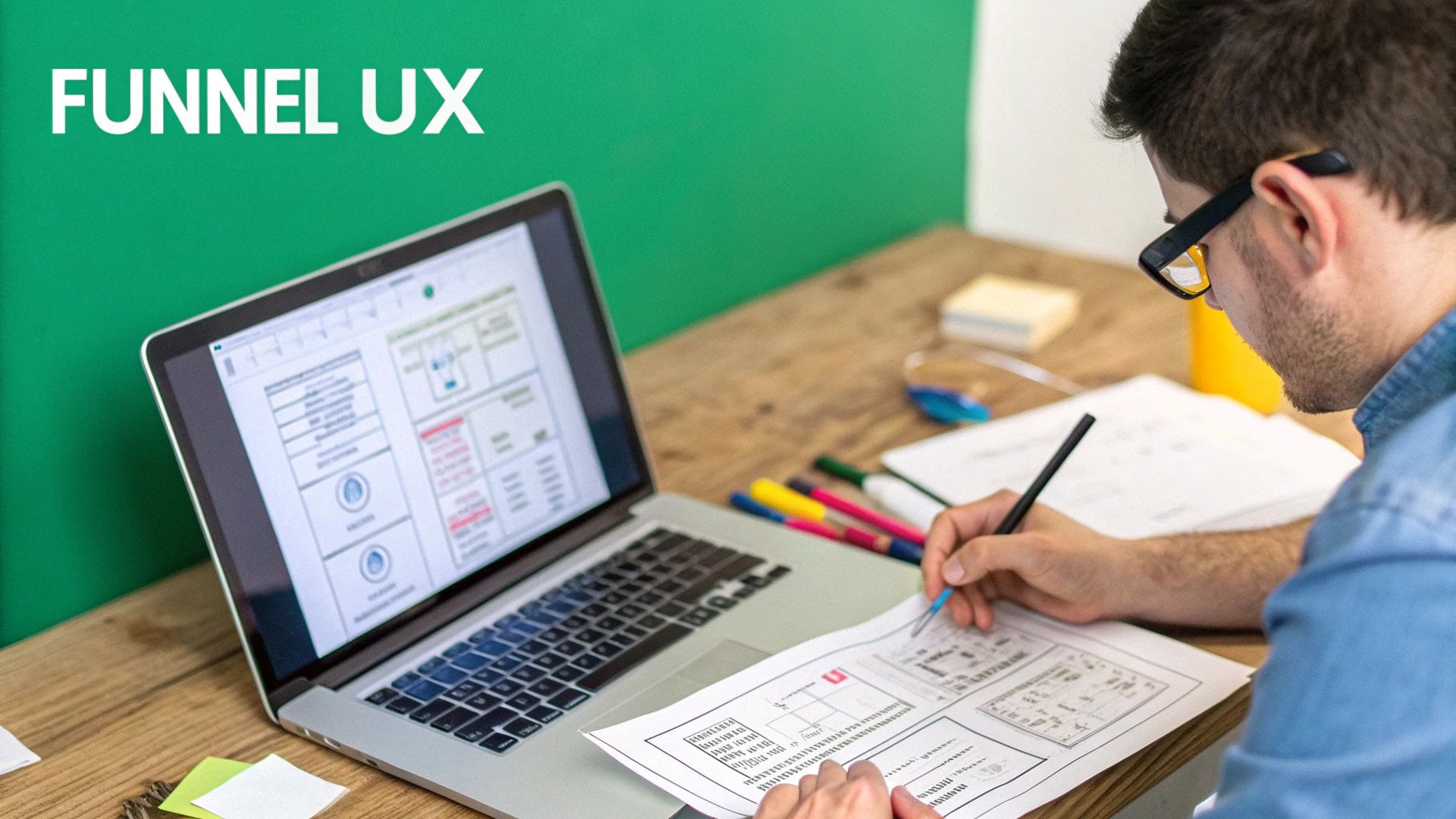
This is where the blueprint becomes a reality. You've already done the hard strategic work, deciding that an interactive tool will outperform a static PDF any day of the week. Now it's time to build the thing—the actual sequence of questions and clicks that will do the heavy lifting of qualifying leads for you.
Here’s a hard-earned lesson from the trenches: the design of your interactive funnel matters far more than the tech stack it’s built on. I've seen ugly-but-intuitive calculators that solve a genuine problem absolutely crush beautiful, confusing messes. Your entire focus needs to be on creating a user experience (UX) that feels completely effortless.
The aim is to make the whole process feel less like a quiz and more like a discovery. You do this by guiding users through a series of bite-sized steps that build momentum and keep them curious about what's next.
100% Free Lead Magnet Audit
Our AI analyzes your website and delivers custom growth strategies in seconds.
Crafting Questions That Qualify Without Annoying
Your questions are the real engine here. Each one has to pull double duty: give the user a small moment of reflection (value for them) and give you a piece of data for segmentation (value for you). The real art is to do this without it feeling like an interrogation.
Always start with the easy stuff. Asking someone about their biggest marketing headache is a much softer entry point than immediately demanding their annual revenue.
- Go Broad, Then Deep: Kick off with questions about their goals or challenges before you start drilling down into specifics like team size or budget.
- Use Multiple Choice: Whenever you can, use multiple-choice options or sliders instead of open text boxes. It makes the experience faster and gives you clean data to work with.
- Frame it Around Their World: Instead of a blunt "What's your budget?", try something like, "Which of these best describes your typical monthly investment in this area?" This small tweak shifts the tone from a sales probe to a helpful diagnosis.
Think of it like a good doctor’s appointment. They don't just walk in and ask, "So, what's wrong?" They guide you through a series of questions that help both of you understand the complete picture.
The Understated Power of Progress and Flow
Never, ever underestimate the psychological pull of a simple progress bar. Just seeing that you're "40% complete" or on "Step 2 of 5" is a surprisingly powerful motivator to see things through to the end. It’s a visual promise that the payoff is just around the corner.
This one tiny design choice directly tackles the number one killer of online forms: abandonment. By breaking what could be a long, daunting form into a multi-step journey, you keep the user focused on one simple question at a time. It’s a simple change that can make a huge difference in your completion rates.
A great interactive funnel doesn't feel like a form at all. It feels like a conversation. Each screen asks one simple thing, shows progress, and makes it dead simple to get to the next step, creating a real sense of forward momentum.
For a deeper look into the architecture of these flows, our guide on choosing a marketing funnel builder breaks down the core principles of designing user journeys that actually convert.
Designing for Mobile Isn’t Optional
Let’s be brutally honest: most of your users are going to find your interactive tool on their phone. If your funnel isn't designed for a small screen from the very beginning, you're dead in the water.
This means putting a premium on:
- Large, tappable buttons
- Readable text that doesn’t require pinching and zooming
- A clean, single-column layout that scrolls naturally
- No complex charts or visuals that are impossible to decipher on a phone
Don’t fall into the trap of designing for a desktop and then trying to shrink it down. Build for the mobile experience first, then adapt for larger screens. This mobile-first approach is the only way to make sure your funnel works for everyone, everywhere.
This kind of accessibility is a huge part of why Small and Medium-sized Enterprises (SMEs) are all-in on sales funnel builder software. They love cloud-based platforms for their ease of use and reach, letting them ramp up customer acquisition without huge overheads. Given that SMEs account for about 99% of all companies, their buying habits are a massive driver for this tech. You can discover more insights about SME software adoption trends here.
The Results Page: The All-Important Payoff
And finally, we get to the most important screen in the entire experience: the results page. This is where you make good on your promise. All the clicks and questions have led to this moment, and a weak payoff can make the entire effort feel like a waste of time.
Your results page absolutely must do three things, and do them well:
- Deliver a Clear, Insightful Result: Don't be vague. Give them a score, a persona, a projected ROI—something concrete that triggers an "aha!" moment.
- Explain What the Result Means: Briefly tell them what that score or category implies. If they’re a "Beginner," what common challenges should they look out for?
- Provide a Compelling Call-to-Action (CTA): This is it. Your CTA can't just be a generic "Contact Us." It needs to be the next logical step based on their specific results. A "Beginner" might get a CTA to download a starter guide, while an "Expert" might be prompted to book a one-on-one strategy session.
Getting this final step right is what turns a neat interactive gadget into a genuine, lead-generating machine. This is where your strategy becomes a real, revenue-driving asset.
Automating Your Follow-Up For Maximum Impact
So, you’ve built a brilliant interactive tool. Someone has just spent two minutes answering questions, received their personalised results, and you’ve captured their email. Mission accomplished, right?
Not even close.
Getting the lead is just the starting whistle. The real power—the part that actually drives sales—is what you do in the moments that follow. The data you’ve just gathered is the key to creating a deeply personal and automated follow-up that makes each prospect feel genuinely understood.
This is how you finally stop sending generic email blasts and start having meaningful conversations at scale.
From Data Points to Personalised Conversations
Think about the goldmine of data you now have. A static lead magnet just gives you an email address. Your interactive funnel, on the other hand, gives you context. You now know their biggest challenge, their industry, or their specific goals. Wasting that information is a massive missed opportunity.
The goal is to use that data to immediately segment every single new lead. This allows you to trigger automated campaigns that speak directly to their unique situation.
For instance:
- The "Novice" User: Someone who identifies as a beginner in your quiz gets a welcome email sequence packed with foundational content, simple tips, and an invite to a beginner-friendly webinar.
- The "Expert" User: An advanced user? They receive a completely different sequence. Maybe it includes in-depth case studies, a technical whitepaper, or a direct link to book a strategy call with a senior consultant.
This isn’t just good marketing; it’s good service. You’re respecting their time by only sending them what’s truly relevant.
Connecting the Wires: Your Automation Stack
To make this magic happen, your sales funnel builder has to talk to your other systems—primarily your Customer Relationship Management (CRM) or email marketing platform. This integration is non-negotiable.
When a user completes your interactive tool, the data they provided—their answers, their final score, their assigned persona—should automatically populate their contact record in your CRM.
The moment a lead finishes your quiz should be the exact same moment your automation engine takes over. The follow-up needs to be instant, relevant, and feel like the next logical step in the conversation you just started.
This connection lets you build incredibly powerful automation rules. For example, you can set up a workflow that says, "If a lead's result is 'High Growth Potential,' add them to the 'Priority Follow-Up' campaign and immediately create a task for a sales rep." This is how you nurture prospects 24/7 without lifting a finger. If you want to dive deeper into the nuts and bolts, you can explore the different components of a complete lead generation system that powers this kind of intelligent follow-up.
Building for Scalability with Cloud-Based Tools
This level of automation might sound complex, but it's more accessible than ever before. The rise of cloud-based sales funnel builder solutions has put this power into the hands of businesses of all sizes, not just giant enterprises. These tools give you the flexibility and scalability needed to manage customer funnels efficiently. You can learn more about the growth of cloud-based sales technology on eMarketer.
What this really means is you don’t need a dedicated IT team to wire everything together. Most modern funnel builders offer native integrations with popular platforms like HubSpot, ActiveCampaign, or Salesforce. Setting up these connections is often as simple as a few clicks, allowing you to build a robust, automated system that grows with your business. It's the engine that turns a one-time interaction into a long-term customer relationship.
Common Questions About Interactive Funnels
As someone who builds these tools for a living, I hear the same questions pop up time and time again when people think about moving from static PDFs to something more dynamic. If you're on the fence, trust me, you're not the only one. Let's dig into some of the most common concerns.
Do I Really Need to Be a Coder to Build One of These?
Let me be absolutely clear: no, you don't. The strategy behind your funnel and the quality of the questions you ask are infinitely more important than the tech you choose.
Sure, custom code gives you ultimate flexibility, but there's a whole world of powerful no-code platforms out there. You can build incredibly slick calculators and assessments using simple drag-and-drop interfaces. I’ve seen straightforward tools, built over a weekend, completely outperform expensive, custom-coded projects. Don't get bogged down by the technology—focus on the user's problem. That’s where the real magic happens.
How Do I Come Up with a Good Idea for an Interactive Tool?
This is my favourite question, mainly because the answer is almost always hiding in plain sight. Just listen. Listen to your customers during onboarding calls or listen to the questions your sales team gets every single day. What’s that first big, meaty question people ask before they’re even thinking about buying?
Often, it’s some kind of diagnostic or calculation:
- "How much could we actually save with a solution like this?"
- "What are the biggest weak spots in our current workflow?"
- "Are we even at a stage where we’re ready for your product?"
Those questions are gold. They're the starting point for brilliant interactive tools because they mirror the first step your ideal customer takes on their journey. If you’re still drawing a blank, you can get a free analysis and some surprisingly sharp ideas from the Magnethive audit tool. It’s a great little resource to get the brainstorming started.
Are Interactive Funnels Actually Better Than Something Like a Webinar?
It’s not really about one being universally "better." It’s about the quality of engagement and qualification you get. Here's a thought that might be a bit controversial: webinars and ebooks often attract an audience of passive learners, not active buyers. People show up to consume information, but that doesn't mean they're ready to take action.
An interactive tool demands active participation. By simply engaging—answering questions and thinking about their own situation—a user is sending a powerful signal. It naturally filters out the tyre-kickers and highlights the prospects who are genuinely motivated to solve their problem.
This process also hands you incredibly valuable zero-party data that a simple webinar sign-up list could never dream of giving you. You learn about their specific pain points and goals, which means your follow-up can be deeply personal and genuinely helpful, not just another generic email blast.